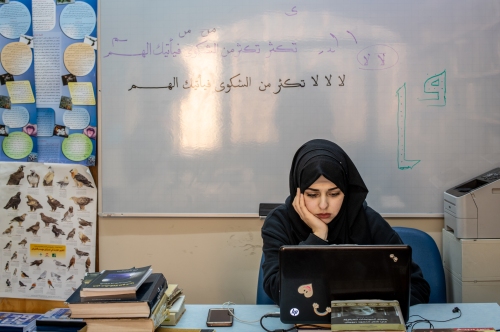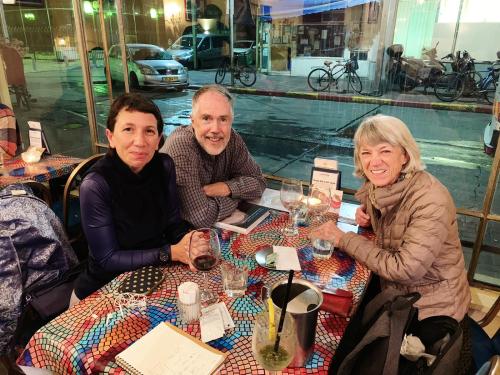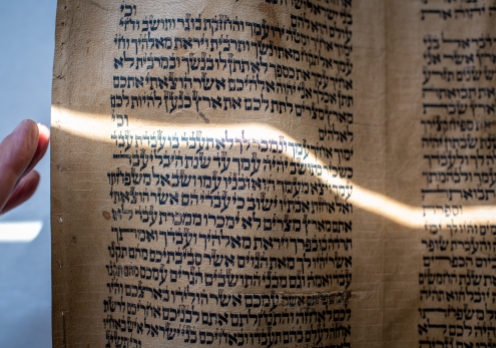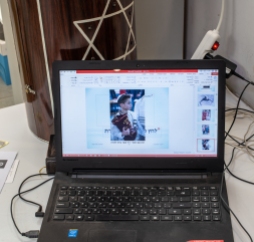3/4/19
Straight Outta Tel Aviv!
Our 15-hour flight flew straight from Tel Aviv to San Francisco, non-stop. Surprisingly, the trip wasn’t as much of an ordeal as I expected. The eight-hour sleep along the way helped (thank you Ambien!). Between the two of us, Ellen and I only binged on watching five films during the trip which also helped.
Our last week in this part of the world was also non-stop and consequential. Because it was Saturday and most things were closed we decided to walk to the Old City and East Jerusalem. Along the Via Dolorosa we came upon the ancient Church of Saint Anne. The austere stone interior and extraordinary acoustics made it a fine example of medieval architecture. It was a fascinating place with holy sites built on top of each other going back to pre-Roman times. A Crusader church was built here on top of a Byzantine basilica which had been built on top of the Pools of Bethesda. The Crusaders thought this was the home of the Virgin Mary and the site of her birthplace. Here we saw a group of African-Americans sitting in a semi-circle signing beautiful hymns. We also saw a group of Russian pilgrims led by a priest with a long beard in Orthodox robes. It was a haunting and impressive place.
We then walked a few hundred yards to the foot of the Mount of Olives and the Garden of Gethsemane. This is where Christians believe Christ underwent his agony in the garden and was arrested the night before his crucifixion. The garden today contains several olive trees that are the oldest known to science. They have been carbon dated to at least 1,000 years old. They may be descended from trees dating back to the time of Christ. They certainly seemed ancient and were completely surrounded by a high fence to protect them from those darn pilgrims that want to break off a branch to take as a souvenir. Large groups of pilgrims came through while we visited. They seemed to mostly come from China, the Philippines and Russia. It was remarkable to be here and I understood why people come from all over the world to be in the presence of these extraordinary trees and stand in this sacred site.


We hiked up the Mount of Olives through various Palestinian olive groves. We could see how they were being squeezed out by new Israeli housing. It also contained a vast necropolis of Jewish grave sites. The mount had been used as a Jewish cemetery for over 3,000 years and had also been a site of Christian worship since ancient times. Recent tensions have arisen here because of vandalism of the Jewish grave sites. The conflict between Jews, Christians and Muslims is partly played out here. As we reached an open space near the top I made an image with my iPhone showing a panorama of Jerusalem. It showed the cemetery on the left, the Muslim Dome of the Rock in the center and a wall with barbed wire on the right. It was all under a gorgeous sunset which made this landscape of conflict even more striking and sad.

The next morning we took a long bus ride through the working-class neighborhoods of southern Jerusalem. We arrived at the office of Mr. Machon Ott, the Torah Doctor. I realized last week while we were photographing at the Special Collections Department at the National Library of Israel that I had not photographed any Torahs while we had been here in Israel. The Library said that they didn’t have much of a collection and recommended that we visit Mr. Ott. He is the son of Holocaust survivors and possessed an intensity of spirit but also a warm, engaging personality that was delightful. He showed us the many Torahs that he had repaired. He told us many stories including one of a German Jewish WWI vet who lost a leg in the war and received an Iron Cross for his bravery. Thinking his war hero status would protect him from the Nazis he stayed in Germany and was eventually sent to a concentration camp. He was protecting a sacred Torah and hid it by using it to replace his wooden leg. Somehow, he survived the war and later moved to Israel. Mr. Ott showed us a picture of the veteran in his WWI uniform and then he showed a photo of the vet’s great grandson carrying the same Torah at the boy’s bar mitzvah. Needless to say, we were very moved.

We then headed off again to East Jerusalem. After a great lunch in an Arab café filled with women in hijabs we went to the Central Library of East Jerusalem. This is a library for the Arab speaking part of the City. Initially it had been difficult to get funding to get it built. In 1985 the popular Jerusalem Mayor Teddy Kollek set aside money from a peace prize he received from the German Publishers Association toward construction of the new facility. With additional help from the Jerusalem Foundation it opened in 1992 and had 20,000 books that were available to Jerusalem residents and Arabic speakers from all over Israel. It survived a terrorist bombing in 1993 and was thriving the day we visited.





There is a saying that there is no rest for the weary. To prove that point, we took a bus the next day to Tel Aviv. I had been trying to photograph the Yitzhak Rabin Center since we arrived in Israel. On this day we received a four-hour private tour of this amazing place dedicated to the memory of the former Prime Minister. We saw much, asked a lot of questions and had the unusual access to photograph Rabin’s private library that was set up exactly as it had been on the day he was assassinated. His murder by a right-wing, ultra-Orthodox nut job changed the course of Israeli history. It helped to usher in the current right-wing government that depends on conservative religious parties to stay in power. The Center also depicts the last 130 years of Jewish and Israeli history from a progressive, Jewish perspective.
We picked up a cab from a driver who was a spitting image of Dennis Hopper from the Apocalypse Now period. He had the same stoner looks, speech and mannerisms along with the greasy long hair. Surprisingly, he was the only person that we met on this whole Fulbright odyssey that liked Trump. He was actually a great character and drove us to the city of Jaffa (or Yafo, depending on who is doing the spelling). This is the ancient city and port that feels more Arab and has a different vibe than neighboring Tel Aviv. In a poor part of the Old City was an Arab-Jewish Community Center that contained a library. The Center and Library were relatively new and it was nice to see the government putting money into helping this poor area in the Arab section of town. The library contained many Arabic language books. I was somewhat surprised to see a children’s book in the Library by Lynn Cheney but I think at this point we had become a little jaded.

We then hopped back into the taxi with Mr. Stoner and headed back to Tel Aviv to another memorial of sorts. Our friend and former Stanford colleague Joel Leivick long ago told me about his grandfather who was a famous Yiddish poet. There was a Leivick House established in Tel Aviv in the 1970s in his honor for writers and poets and this was where we briefly visited.

We ended the evening having dinner with our Fulbright colleague and now friend Noa Turgeman. She was the first person we met when we landed in Israel two months ago and she really impressed us then. She had done great work for us by helping to coordinate our Fulbright work in Israel. She will be missed along with several other new friends we have made over our time here. After dinner, we took the bus back to Jerusalem that night and I had to stand on the crowded bus for the hour-long ride. Again, no rest for the weary.

Speaking of no rest, we then got up at the crack o’ dawn and took a very long bus ride to Bethlehem. We had been told that we shouldn’t go into the West Bank because of the danger but felt that on this last day of my photography we should visit some libraries in Palestine. We hired a wonderful driver named Alaa’a who drove us to the cities of Al-Bireh and Nablus. Alaa’a was a chatterbox and an intense Palestinian nationalist. He was also the “official driver” for the artist Banksky’s famous Walled Off Hotel in Bethlehem that we had visited earlier on this trip.
It was good to get the Palestinian perspective on the situation in Palestine. Alaa’a pointed out the Israeli settlements all over the West Bank. He showed us the Israeli Army working hand in hand with the settlers; the check points; the long and circuitous roads Palestinians must use and; of course, the never-ending Wall. Most of all he expressed the indignity that many Palestinians felt under occupation of their own country. As long and hard as it had been to achieve, the only answer seemed to be a two-state solution. Israeli policy seemed driven by fear and frustration and Netanyahu seemed to have expertly exploited that for his own political gain. I fear that the West Bank will blow up again someday and I was hoping it wouldn’t occur on the day we were there.
One very welcome counter-point to this gloomy picture was the Al-Bireh Public Library. Al-Bireh and neighboring Ramallah are basically one big city. Ramallah is the de facto capitol of Palestine and gets more attention. But Al-Bireh was larger and much older. We were greeted by the very well organized and professional staff of the library. Many people in Al-Bireh have lived in the United States including our main guide who lived for many years in Colorado. We got a grand tour of the new and very nice library and community center. Although the library has only six employees, it maintains six-days-a-week service. The history of the Al-Bireh Public Library is entwined with that of Palestinian resistance. In the past it has been hard for them to get books because of Israeli law. Even though they are struggling I felt this was an impressive, important and extremely well-run place.
After an hour-long drive north through the heart of the West Bank we arrived at the beautiful and fascinating city of Nablus. This city has been around since Roman times. The Roman name Flavia Neapolis (New City) was later pronounced by the Arabs as Nablus. It has been a hotbed of Palestinian activism not least because the surrounding hills are occupied by some of the West Bank’s most hard-core Israeli settlers. The Nablus Library was the oldest and largest public library in the West Bank. It was started with aid from the Jordanian government in the 1960s. It was housed in a 19th century Ottoman-era structure. Its collections included the Prisoner’s Section which was an archive of materials made and used by Palestinian prisoners held in Israeli jails between 1975 and 1995 as part of a Palestinian self-education movement.

When we arrived at the library we met the director. Through an interpreter we learned that he planned for us to visit the Mayor of Nablus at that moment. I explained to him that we only had one hour left before the library closed. I asked if we could meet with the Mayor after that hour but he was adamant and kept repeating that “the Mayor is waiting.” I realized this was the last library of our six-month Fulbright project and it may be a bust. I also realized we were walking a fine line here and I feared this could escalate into something of an international incident. After further pleading for a few minutes to photograph before we ran off to the Mayor I literally sprinted around the library photographing whatever I could on the fly. Fortunately, I made what I think were a few good images.


We then walked 20 minutes to the Mayor’s office with a guide who spoke no English. Ellen snapped this photo along the way.

When we arrived, of course, the Mayor was busy and kept us waiting for at least an hour. We had a wonderful chat with his younger assistant who spoke excellent English and told us all about Nablus. I began to feel that the Mayor didn’t really care about meeting us one way or another. I also thought the library director did this as a way of making himself look good to the Mayor. I have no idea of what the pressures of life must be like under an occupation but I really couldn’t understand the unprofessional actions of the Nablus library director. The last picture of the project was of us standing with the Mayor in front of large portraits of Mahmoud Abbas, the current Palestinian leader and Yasser Arafat, the former leader of Fatah and of Palestine. Abbas is considered corrupt by many Palestinians and Arafat is considered a terrorist by many Israelis and some Americans. Others consider Abbas is in a tough situation with an asymmetrical relationship with Israel. And others consider Arafat a great leader and a Nobel Peace Prize winner for signing the Oslo Peace Agreement. It all seemed quite surreal but a fascinating ending to a fascinating journey.

As we took the long drive home through West Bank to Bethlehem we drove past many reminders of the current crisis in this part of the world. Alaa’a finally dropped us off to take a bus for the final leg of our journey into Jerusalem. Even though he has lived here his whole life he can’t drive into Jerusalem because he doesn’t have the right papers. At the border the bus stopped and all the passengers under 50 had to go outside into the freezing cold to have their passports inspected. After the machine gun toting Israeli guards inspect our passports and the under-50s are allowed back on the bus, we drive through the check point into the night and back to Jerusalem.


As with Greece and Italy, we found it difficult to leave Israel and Jerusalem. I have found this city hard to love but also found it one of the most fascinating places we have visited on a trip full of fascinating places. We were honored to have had the opportunity to get to know it and hope to come back many more times.
We spent our last full day shopping for gifts in the windy and freezing rain. I photographed Ellen with a broken umbrella in front of a trolley stop with Israeli soldiers carrying the ever-present machine guns.

On our last day we take a cab to the Ben Gurion airport and it starts to hail heavily. I remember the first time we drove into Jerusalem it snowed that night. That was the beginning of our Walk on the Wild Side. Abruptly the storm ended, the clouds parted and we saw the most beautiful sunset. At the airport Ellen photographed me with six-months-worth of luggage heading to the plane that will take us back to the City where we had left our hearts.
I have enjoyed doing this blog and I have heard that many of you have enjoyed it too. It certainly helped me to focus my thoughts and it also acted as a public diary of our trip. With so much happening over the last six months I am sure I would forget much of it without writing the blog. I will now have some time to make sense of this Fulbright odyssey and hope to continue an occasional blog with any insights I may discover. Thanks for sharing this remarkable journey with us. Until then…
Back to the Cool Gray City of Love.












































































